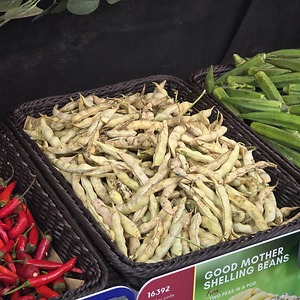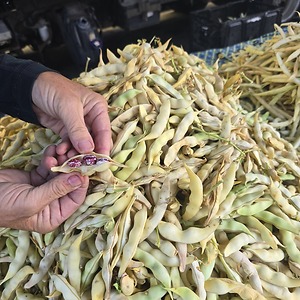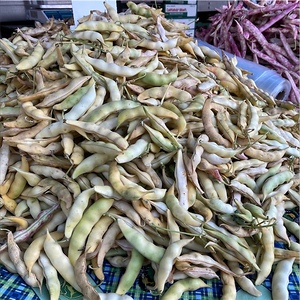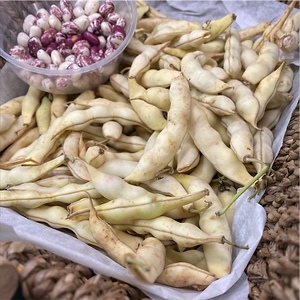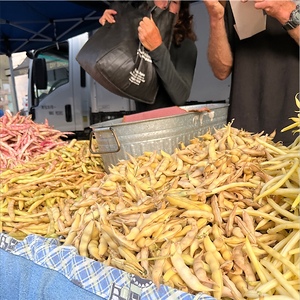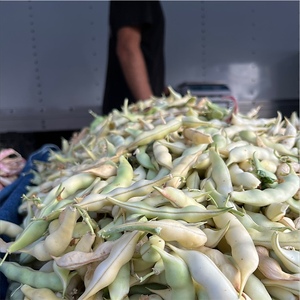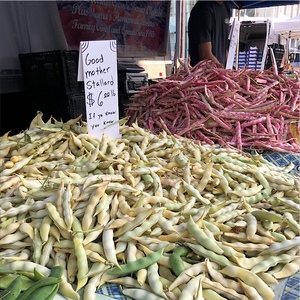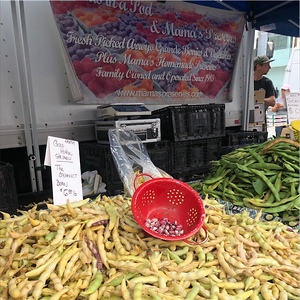

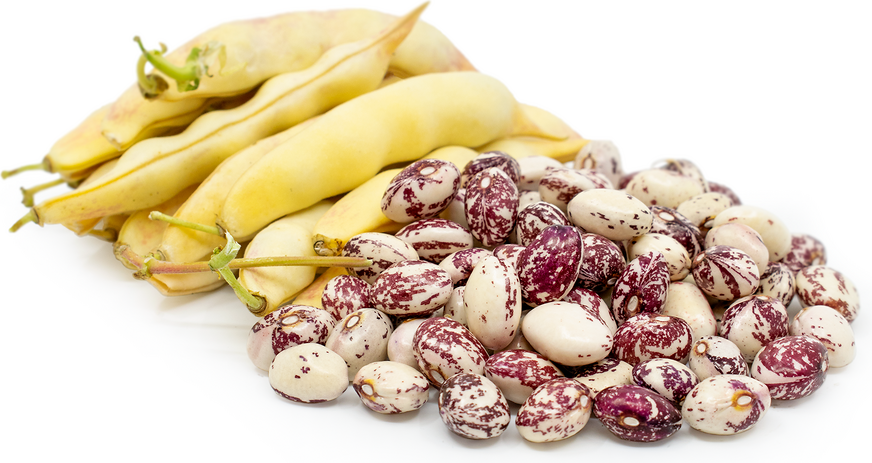
Good Mother Shelling Beans
Estimated Inventory, lb : 0
This item was last sold on : 09/24/24
Description/Taste
Good Mother Stallard shelling beans are comprised of thick, fibrous pods, averaging 7 to 10 centimeters in diameter, and have a curved to bumpy shape, showcasing the outline of the enclosed seeds. The pods are inedible and left on the vine to mature from green to hues of yellow and ivory. As they ripen, the pods will begin to dry out, developing a shriveled appearance. Within the pod, there are 4 to 6 round to oval seeds that are large, plump, glossy, and dense. The seeds, also known as beans, display a distinct variegated pattern of maroon and white swirls and speckles. When cooked, Good Mother Stallard shelling beans develop a creamy, velvety texture and contain a combination of rich, mild, earthy, nutty, and subtly fruity flavors.
Seasons/Availability
Good Mother Stallard shelling beans are harvested from the vines in the late summer through early fall. Once dried and cured, the beans are available in limited quantities year-round.
Current Facts
Good Mother Stallard shelling beans, botanically classified as Phaseolus vulgaris, are an heirloom variety belonging to the Fabaceae or legume family. The colorful beans are a pole-type variety, growing on tall vining plants that can reach up to 3 meters in height and are primarily grown as a dry shelling bean. Good Mother Stallard shelling beans are harvested from the plants once the pods and beans have fully matured and dried. The variety has been known in the United States since the early 20th century, but for many years the cultivar almost completely disappeared from seed catalogs. In the late 20th century and early 21st century, Good Mother Stallard shelling beans remerged from personal heirloom collections and became a specialty cultivar grown by bean enthusiasts. Good Mother Stallard shelling beans are highly prolific, easy-to-grow, aesthetically attractive, and are favored by chefs for the bean’s dense, rich flavor.
Nutritional Value
Good Mother Stallard shelling beans are a good source of fiber to stimulate the digestive tract, potassium to balance fluid levels within the body, zinc to strengthen the immune system, and iron to develop the protein hemoglobin to transport oxygen through the bloodstream. The beans also provide thiamine, a vitamin that helps turn food into energy and contain manganese, magnesium, and folate.
Applications
Good Mother Stallard shelling beans are best suited for cooked applications, including steaming, frying, and simmering. Despite their unique coloring when dried, the beans do not retain their vivid appearance once cooked, but some faint speckling may remain, depending on the preparation. Good Mother Stallard shelling beans hold their shape well when heated, making them a preferred bean for soups, stews, and chilis. The beans can be used as a substitute for other dry shelling beans in recipes and can be cooked and tossed into salads and pasta or blended into creamy dips. The beans can also be baked into casseroles, incorporated into tacos and quesadillas, mashed into a meatless burger patty, or cooked into refried beans. In addition to using the beans, Good Mother Stallard shelling beans develop a flavorful liquid when cooked that can be used as a soup broth or flavoring in sauces and main dishes. Good Mother Stallard shelling beans pair well with herbs such as oregano, basil, thyme, and rosemary, tomatoes, celery, carrots, dark leafy greens, aromatics including garlic, onions, and shallots, and meats such as beef, poultry, and pork. The dried beans will keep 1 to 2 years when stored in a sealed container in a cool, dry, and dark place away from direct sunlight. The beans can also be cooked and frozen for 2 to 3 months.
Ethnic/Cultural Info
Good Mother Stallard shelling beans were preserved primarily through the efforts of John Withee. Once a medical photographer, Withee purchased land in Lynnfield, Massachusetts, and sought to recreate fond memories from his childhood, including an underground oven to bake beans. Withee searched for beans he was familiar with in his youth, but he could not find many of the heirloom varieties, inspiring him to develop a nonprofit dedicated to bean preservation. Withee drove to food stores across New England and even ventured up to Maine to acquire heirloom beans, and he also developed a national network of bean enthusiasts who would send him varieties from their home gardens. In 1981, Withee had collected 1,186 varieties of heirloom beans and received widespread recognition for his efforts to inspire bean biodiversity. Withee eventually donated his collection to Seed Savers Exchange, which at the time was a small seed saving group. Through Withee’s collection, Seed Savers Exchange expanded and ultimately became one of the largest public seed banks in the United States.
Geography/History
Good Mother Stallard shelling beans are somewhat shrouded in mystery and are believed to have been present in American gardens since the 1930s. The heirloom beans were given to Seed Savers Exchange in 1981 through John Withee, a bean collector from Massachusetts who donated more than 1,186 varieties of beans. Withee received Good Mother Stallard shelling beans from a lady in Wise County, Virginia, known as Carrie Belle Stallard, and Withee named the cultivar after her last name. Good Mother Stallard shelling beans have been preserved through Seed Savers Exchange since the 1980s, and in the modern-day, the variety is offered through online seed catalogs for home garden use. Good Mother Stallard shelling beans also experienced a resurgence in popularity among gardeners in 2016, credited to farmer and seed preserver Glenn Drowns of the Sand Hill Preservation Center of Iowa. Drowns reintroduced the beans to Seed Saver Exchange members in the early 2000s, increasing awareness of the heirloom and encouraged gardeners to try cultivating the variety.
Recipe Ideas
Recipes that include Good Mother Shelling Beans. One



